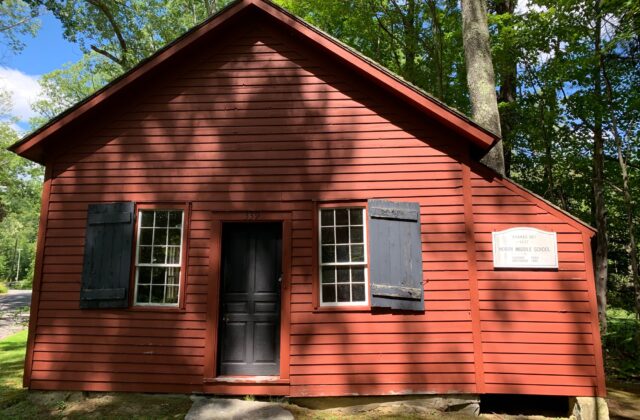Back to Schools
A tour of Norfolk’s one-room schoolhouses
By Andra Moss
It’s September and that means that school, whatever form it takes, is back in session.
In the 19th and early 20th centuries, most American students attended a one-room schoolhouse within walking distance of their homes. In 1919 there were 190,000 one-room schools scattered throughout the American countryside. Within each, a single teacher taught grades one through eight. Local historian Alice Waldecker found that in 1900 Norfolk had 10 district grammar schools for a town of 1,614 people with 340 school-age children.
Ready for your first pop quiz of the school year?
Q: How many Norfolk one-room schoolhouses can still be found as extant buildings (including those converted into homes)?
- three b) four c) seven d) what does “extant” mean?
Answer: seven! Yes, you can drive or bike past seven former one-room Norfolk schoolhouses—one of which, due to a dizzying student population of 44 in 1900, was expanded into a two-room schoolhouse.
Let’s take a spin around Norfolk’s earliest schools. Bonus points if you can match the buildings to their original school districts and locations!

Norfolk’s North Middle School was built in 1827 and closed in 1922. According to the Hartford Courant of Aug. 4, 1961, “The school house formerly known as the North Middle School is the town’s only remaining one-room school. It has been completely restored by community projects and was first opened to the public on July 22 and 23.
Renamed the “Little Red School House,” it can be found at the intersection of Ashpohtag and Bald Mountain Roads. Peek through the windows for a lovely bit of time travel.

Meander west along Ashpohtag until it nearly meets Route 44 and you’ll find the West Norfolk District School. This is the famous “two-room” school which also meant…two teachers! The Hartford Courant reported on Dec. 26, 1903, that: “The West Norfolk school closed Thursday for a two weeks’ vacation. A program of songs and recitations was rendered by the children, after which the scholars enjoyed a Christmas tree furnished by their instructors, Misses Flyn and Relihan.”

Heading back to 272, a journey north to the Canaan Valley Road turn-off will lead you to the lovely home/schoolhouse of the a) Mountain Laurel District b) Waterfall District c) North Norfolk District. (Alas, C).HOTO: South Norfolk District School

Rolling down 272 to Estey Road, one finds the 1860 South Norfolk School, remarkably unchanged from the outside and marvelously repainted a perfect schoolhouse red.
The Courant noted an impressive extracurricular activity at the school in its Dec. 15, 1916, issue: “Pupils of the South Norfolk school have recently organized a “press association” known as “The Busy Printing Company” and are issuing a monthly paper, “The South Norfolk Gazette.” The treasurer of the company is Eliner E. Humphrey and the managing editors are Misses Ellen and Alice Brown. The paper is printed entirely by hand and the time spent is usually at recesses and the noon hour.”

Returning up 272, take a right onto Winchester Road and enjoy the soft hills that bring you to the Grantville area and, if you are sharp-eyed, the South End School. It was moved from the corner of Schoolhouse Road sometime before 1950 and integrated into a very sweet house, but the roofline hints unmistakably at its true origins.

Back once again on Route 272 towards town, take a left onto West Side Road, following its scenic brook and meadows curve to the intersection with Windrow Road. Tucked back and not much bigger than the nearby chicken coop is the Crissey District Schoolhouse. Records show ten students attending in 1900; it might have actually been a little tight.
Take a bonus loop around the Village Green just to soak in its perfect Village Green-ness (and to recall that the Historical Society building was once the private Norfolk Academy) and head up Route 44 for our final stop, the East Middle District School. Not since it was first built prior to 1810 has there been as much buzz about a “new” schoolhouse.

Co-owners of Kingsland Architectural Millwork, Matthew and Henry Burke, are just completing a full renovation of the building. and it is special indeed. They note that much of the original clapboard remains on the school building (the other small attached structure was a wood/coal storage shed), as well as 60 panes of original glass, the post and beam ceiling, a 1901 flag pole, and the same stone entry steps that have welcomed visitors for more than 200 years. Although a simple building constructed by farmers, the Burkes find much to appreciate, as professionals. Says Matthew, “It was a functional building, but it was solid and really works.” Henry agrees, pointing to how pleasing the structure is to the eye: “The proportions are just right—exactly measured. It gives it a very special look.”

